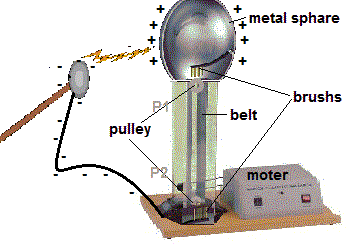Van de Graaff Generator
Van De Graff generator is used to generate high potential differences of near about million volts. The high voltages generated by the generator can be used for accelerating subatomic particles to high speeds, making the generator a useful tool for fundamental physics research. It can be used to demonstrate the presence and nature of electric fields and the functioning of the Van de Graaff Accelerator. A Van de Graaff generator is an electrostatic generator which uses a moving belt to accumulate very high amounts of electrical potential on a hollow metal globe on the top of the stand. It discharges to a smaller sphere and, in ideal conditions, it can produce a voltage of 400,000 volts with a short circuit current of 20 micro- amps. It was invented by American physicist Robert J. Van de Graaff in 1929. The potential difference achieved in modern Van de Graaff generators can reach 5 megavolts. A tabletop version can produce on the order of 100,000 volts and can store enough energy to produce a visible spark.
Two main principles of Van De Graff Generator
It is designed on the basis of the property that the charge given to a conductor which is hollow inside, is transferred to the outer surface and scatters uniformly over it.
It is founded on the phenomenon of Corona Discharge.
Components in Van De Graaff Generator
Outer terminal (An steel/aluminum sphere)
Upper brush (A piece of fine metal wire)
Upper pulley (P1) (A piece of nylon)
one long narrow conveyor belt of insulating material (like Silk, rayon or rubber) wound around the pulleys P1 and P2 Motor
Lower brush
Lower pulley (P2) (Piece of nylon covered with silicon tape)

Use of Van de Graaff generator
The Van-de-Graaff generator is an electrostatic-accelerator is being used for scientific experiments to get high voltages in less time with a high safety factor and the generated charges are used to speed up subatomic particles.
